A New World of Research | Reversing Diabetes | Fighting HIV, Naturally | Supercharging Chemotherapy | CRCs, New and Renewed |
Visionary Breakthrough | The Roots of Suicide | You’re Getting McSleepy, So Very McSleepy… | Where Cancer Grows | Accolades for Macaulay
A New World of Research
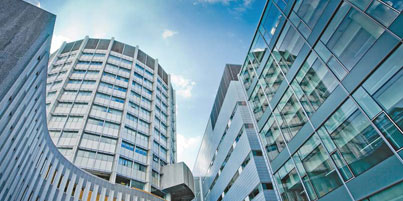 With the September 18, 2008 opening of the McGill University Life Sciences Complex, McGill began a new chapter of innovative interdisciplinary research.
With the September 18, 2008 opening of the McGill University Life Sciences Complex, McGill began a new chapter of innovative interdisciplinary research.
The 340,000-square-foot complex—which, with a $73.2-million price tag, is the biggest construction project in McGill history—links the extensively renovated McIntyre Medical and Stewart Biology buildings to two new buildings: the McGill Cancer Research Building and the Francesco Bellini Life Sciences Building. Francesco Bellini is the co-founder of BioChem Pharma, the Montreal company that helped bring 3TC, the first anti-HIV compound drug, to the public.
Physically joining the four buildings—collectively home to over 2,000 researchers, technical personnel, graduate students and postdoctoral fellows—is important to the LSC philosophy, which holds that working in close quarters is crucial for nurturing the free flow of information across diverse fields and speeding the rate of life-saving discovery.
“We’re entering into an exciting venture that amplifies our strengths in biological and medical research,” says Dr. Richard Levin, Vice-Principal (Health Affairs) and dean of the Faculty of Medicine. “The Life Sciences Complex lays the foundation for medical and scientific researchers to uncover the biological basis of disease, translate research into better health and patient care and train tomorrow’s leaders in the health sciences.”
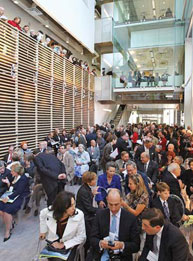
“This is an enterprise which brings the best of McGill under one roof,” adds Martin Grant, Dean of the Faculty of Science. “It unites Science and Medicine and brings pure research together with the quest for practical applications.” The Bellini Building, for example, is shared by biologists, biochemists and physiologists, as well as scientists in the Centre for the Study of Host Resistance. On the same note, the LSC brings together the McGill Cancer Centre (established in 1989) with the Molecular Oncology Group to create the new Rosalind and Morris Goodman Cancer Centre; this expanded centre includes facilities in the Cancer Research and McIntyre Medical buildings. Morris Goodman co-founded the Montreal-based Pharmascience Inc. The Goodmans have also endowed a new chair in cancer research.
In addition to consolidating existing McGill talent, the LSC is attracting new brainpower to the University. Professor Paul Lasko says the LSC is already luring international top-drawer talent, citing the arrival of professors Nam-Sung Moon and Gary J. Brouhard, formerly of Harvard University and the Max Planck Institute of Molecular Cell Biology and Genetics, respectively. “We didn’t even interview people like that before we got this new facility,” says Lasko, leader of the Developmental Biology Research Initiative and chair of McGill’s Department of Biology. “We didn’t feel that we were competitive.”
The Life Sciences Complex isn’t just dedicated to improving human health, either. McGill’s Senate Sub-Committee on the Environment helped shape the design of the new buildings, giving careful consideration to “green” issues of sustainability, water efficiency, energy use and construction.
This project received funding from the Government of Quebec and the Canada Foundation for Innovation.
Reversing Diabetes
Much of the search for a diabetes cure hinges on a single question: can insulin-producing pancreatic cells regenerate? A study by researchers from McGill University, the McGill University Health Centre (MUHC) and the Centre hospitalier de l’Université de Montréal (CHUM) has come up with an answer.
The study, published in the July issue of the journal Laboratory Investigation, shows that under laboratory conditions the cells which make up the islets of Langerhans (the part of the pancreas which secretes insulin) can return to a more primitive developmental state called stem-like cells. This process is called “de-differentiation.”
“The potential for de-differentiation of all the different cells that make up the islets of Langerhans is a totally new finding,” says Dr. Lawrence Rosenberg, Chief of the Division of Surgical Research and Professor of Surgery and Medicine at McGill’s Faculty of Medicine, and the A.G. Thompson Chair in Surgical Research at the MUHC. Rosenberg and CHUM’s Dr. Bernard Massie were the study’s principal investigators. “At this stage, we can’t confirm whether the cells’ ability to turn into stem-like cells occurs naturally in a healthy pancreas, but the results are very encouraging for the development of regenerative therapies to fight diabetes.”
The cells’ in-vitro plasticity opens up new avenues of investigation into the underlying causes of diabetes. This study is the latest step in an extensive regenerative therapies research program based on a peptide called islet neogenesis associated protein, or INGAP. Rosenberg and his colleagues have demonstrated INGAP’s potential to induce new islet formation in the pancreas. Clinical trials with INGAP have already demonstrated that it is possible to regrow new functional insulin-producing cells in diabetic patients.
“We know that the peptide works, but we are still lacking certain theoretical bases to explain its mechanism,” says Rosenberg. “This finding will allow us to move ahead on firmer ground.”
This study was funded by the Canadian Institutes of Health Research (CIHR) and the Stem Cell Network of Canada. Additional support was provided with fellowships from the Canadian Diabetes Association/CIHR and the Fonds de la recherche en santé du Québec (FRSQ). Dr. Rosenberg was supported as a chercheur national by the FRSQ.
Fighting HIV, Naturally
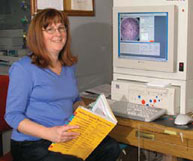
Some people seem to have a natural resistance to HIV, and a new study by the Research Institute of the McGill University Health Centre and the Centre hospitalier de l’Université de Montréal is getting closer to explaining why.
The researchers compared the genetic profiles of people in their first year of HIV infection to those of people who had been repeatedly exposed to the virus yet remain uninfected. The simultaneous expression of certain versions of two genes related to the immune system, KIR3DL1 and HLA-B*57, appears to cause people to resist HIV infection or develop AIDS at a slower rate. Analyses revealed that 12.2 per cent of the exposed but uninfected subjects carried the “good” versions of both genes; only 2.7 per cent of primary HIV patients carried the genes.
It is unclear exactly how this genetic combination fights HIV. “More research is needed to determine the exact mechanism behind the protection we have observed, but these findings have revealed a promising avenue,” says Dr. Nicole Bernard, a researcher in the Infection and Immunity Axis of the Research Institute of the MUHC, who published her findings in the journal AIDS. “In the future, our findings could be used to somehow ‘boost’ the innate immune system and thus fight the virus as soon as it enters the body.”
This study was funded by the Canadian Institutes of Health Research (CIHR) and the Fonds de la recherche en santé du Québec (FRSQ).
Supercharging Chemotherapy
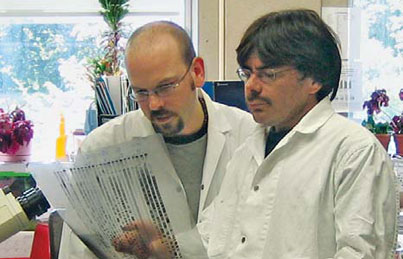
Chemotherapy continues to be one of the most effective methods for combating cancer, but its success is hardly a sure thing.
“One of the major problems with cancer therapy,” says biochemistry professor Jerry Pelletier, “is that the tumours either fail to respond or stop responding over time to various chemotherapy drugs.” Pelletier and a team of McGill researchers have discovered a natural compound that seems to give chemotherapy the upper hand when pitted against stubbornly resilient tumours. Their study was published in the Journal of Clinical Investigation.
Working with mice genetically modified to mimic human leukemia, the scientists probed the effectiveness of a class of natural products known as cyclopenta benzofuran flavaglines (CBF). The McGill team discovered that one particular CBF compound, silvestrol, can re-sensitize leukemia cells which had previously demonstrated resistance to the chemotherapy agent doxorubicin.
“Essentially, we have turned off the cancer cell’s survival signals, which is associated with resistance,” Pelletier says.
Silvestrol is derived from trees and shrubs in Malaysia, southern China and some Pacific islands. Although used in Malaysian folk medicine for generations, it has never before been employed as a cancer treatment; researchers still need to determine if silvestrol can be similarly effective in resensitizing cancer cells in humans.
This research was supported by grants from the National Cancer Institute of Canada and the Canadian Institutes of Health Research (CIHR).
CRCs, New and Renewed
On September 30, 2008, the Canada Research Chairs Program announced the appointment of 123 new CRCs, including McGill University researcher Ross Andersen as the new Canada Research Chair in Physical Activity and Health. Andersen joins McGill’s two other new CRCs announced on June 10: Delphine Collin-Vézina (child welfare) and Samer Faraj (technology, management and healthcare). In addition to the three new chairs, 16 McGill CRCs were renewed:
• Gary J. Bennett, pain control
• Maxime Bouchard, kidney disease
• Eric Fombonne, child and adolescent psychiatry
• Alyson Fournier, regenerative neuroscience
• Imed Gallouzi, cellular information systems
• Yosef Grodzinsky, neurolinguistics
• Reghan J. Hill, colloids for advanced materials
• Hans C.E. Larsson, vertebrate paleontology
• Jeffrey S. Mogil, the genetics of pain
• Keith Murai, molecular control of synaptic structure
• Arnim Pause, molecular oncology
• Salman T. Qureshi, host resistance to fungal pathogens
• Bruce A. Reed, graph theory
• Peter Swain, systems biology
• David Y. Thomas, molecular genetics
• Debra A. Titone, cognitive neuroscience of language and memory
The 19 chairs have a value of $15.8 million. The Canada Foundation for Innovation is also investing $582,686 to fund research infrastructure essential to the work done by Andersen, Collin-Vézina, Fournier, Gallouzi and Hill. McGill is now home to 137 CRCs. The Government of Canada created the CRC program in 2000 to establish 2,000 research professorships across the country by 2008, with the aim of making Canada one of the world’s top five countries for research and development. McGill has since used its CRCs to recruit exceptional international researchers and to repatriate outstanding Canadian and Quebec researchers.
Visionary Breakthrough
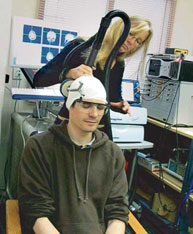
Amblyopia, the vision disorder colloquially known as “lazy eye,” has been long thought untreatable in adults. New work at the McGill Vision Research Unit (MVRU), however, shows that magnetic stimulation can temporarily reverse the condition.
Amblyopia is characterized by poor or indistinct vision in an eye that is physically normal. The condition is usually the result of the brain not learning to properly adjust to childhood conditions like strabismus (“crossed eyes”) or anisometropia (unequal refractive power in the right and left eyes). If amblyopia isn’t treated by adolescence, it’s been assumed the visual cortex becomes locked in its “lazy” habits—even when the eye condition itself has been corrected.
A new study—led by post-doctoral fellow Dr. Benjamin Thompson and MVRU director Dr. Robert Hess—shows that 15 minutes of repetitive transcranial magnetic stimulation (rTMS), the painless application of rapidly changing magnetic fields to the head, temporarily improved vision in amblyopic eyes. The magnetic fields induce weak electric currents within the brain, which excite neurons in targeted areas. This safe and painless technique has been used to treat Parkinson’s disease, migraines and clinical depression, and to facilitate recovery from stroke. This study marks the first known application of rTMS to amblyopia.
“A very short intervention could improve vision in the amblyopic eye for up to 30 minutes,” Thompson reports. “This suggests that visual loss is not due to loss of brain cells but due to an ongoing suppression of their activity that can be reversed, allowing the potential for rapid recovery of vision.” The team hopes that repeated rTMS treatments may lead to longer-lasting effects. “Our ideas about this age-old problem are currently in rapid transition,” adds Hess, an internationally renowned amblyopia expert. “It was previously believed that treatment of amblyopia in adults was a waste of time.” The results of their study were published in the July 22 issue of the journal Current Biology.
This research was funded by the Canadian Institutes of Health Research (CIHR).
The Roots of Suicide
Victims of child abuse might experience biochemical changes to their brains that leave them more vulnerable to suicidal urges as adults.
A McGill research team—including psychiatry professor Michael Meaney, pharmacology and therapeutics professor Moshe Szyf, post-doctoral fellow Patrick McGowan and Dr. Gustavo Turecki, Director of the McGill Group for Suicide Studies at the Douglas Mental Health University Institute—compared the epigenetic marking in brains of men who had taken their own lives (and who had all experienced abuse as children) with those of accident victims who had grown up under non-abusive circumstances. While DNA is inherited and remains fixed throughout life, the functioning of its genes is influenced by epigenetic marks, a chemical coating which appears to be sensitive to environmental factors early in life. In comparing the brains in the two groups, the McGill team found evidence of epigenetic differences in the protein-synthesizing machinery, essential for learning, memory and the building of new connections in the brain. It is also linked to decision-making. The study was published in the journal Public Library of Science One.
“It’s possible the changes in epigenetic markers were caused by the exposure to childhood abuse,” says Szyf. “The big remaining questions are whether scientists could detect similar changes in blood DNA—which could lead to diagnostic tests—and whether we could design interventions to erase these differences in epigenetic markings.”
This research received funding from CIHR, the Human Science Frontiers Program and the Sackler Program in Developmental Psychobiology and Epigenetics.
You’re Getting McSleepy, So Very McSleepy…
The first of Isaac Asimov’s Three Laws of Robotics states that “a robot may not injure a human being.” That may be so, but McGill researchers have designed an automated anesthesiologist that can gently knock you out.
“McSleepy,TM” the new system, administers drugs for general anesthesia and monitors their separate effects with no manual intervention. In fact, McSleepy recently performed the world’s first totally automated administration of an anesthetic on a patient undergoing a partial nephrectomy, a three-and-a-half-hour procedure involving the removal of a kidney tumour while leaving the non-cancerous part of the kidney intact.
“We have been working on closed-loop systems, where drugs are administered, their effects continuously monitored, and the doses are adjusted accordingly, for the last five years,” says associate professor of anesthesia Thomas Hemmerling, who heads ITAG (Intelligent Technology in Anesthesia research group), a team of anesthesiologists, biomedical scientists and engineers. McSleepy “thinks like an anesthesiologist, analyzes biological information and constantly adapts its own behaviour, even recognizing monitoring malfunction.”
The difference is McSleepy can calculate the appropriate drug doses for any given moment of anesthesia faster and more precisely than a human can.
Still, don’t expect McSleepy to fly solo during an operation anytime soon. The automated anesthesiologist assists its human counterparts the same way an automatic transmission assists drivers: by taking over some duties, it frees humans to better concentrate on other aspects of patient care, such as monitoring their patients’ breathing and circulation. McSleepy can also communicate with personal digital assistants, allowing an anesthesiologist to keep tabs on surgery while quickly checking up on another patient in a recovery room.
Hemmerling believes it will take about two years to perfect the system and hopes that a commercial system might be available within the next five years.
This research received funding from the Research Institute of the McGill University Health Centre.
Where Cancer Grows
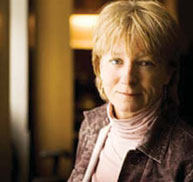
Gardeners know that a plant can flourish in one microclimate, yet flounder a few feet away. Now scientists from the Research Institute of the McGill University Health Centre (MUHC) have learned that similar microenvironments not only exist within the human body, but play a crucial role in determining whether cancer cells prosper or fade.
The MUHC team analyzed tissue from 53 breast cancer patients. Using laser capture microdissection (LCM), they separated tumour cells from their surrounding microenvironment tissue, then analyzed the gene expression evidenced in this tissue. From thousands of genes, the McGill researchers identified 163 that correlated with patient outcomes, either good (no tumour metastasis or migration) or bad (non-responsiveness to therapy). The team further identified a panel of 26 genes that could be used to accurately predict clinical outcome. This 26-gene profile, called the stromal-derived prognostic predictor (SDPP), was used to correctly forecast the outcomes in a second set of breast cancer patients.
“A tumour cannot exist on its own. It has to be supported and nourished by the cell types around it, the microenvironment,” says senior author Morag Park, Director of the molecular oncology group at the Research Institute and also the newly appointed Scientific Director of the Canadian Institutes of Health Research’s Institute of Cancer Research.
“Different patients have distinct tumour microenvironments. Our findings show that the gene profile of these distinct microenvironments can be used to determine who will fare well and who will not.” The team, which published its findings in Nature Medicine, is now developing SDPP into a functional diagnostic test, which they anticipate will be ready for clinical trials within a year.
This research was supported through the Quebec Breast Cancer Foundation, Genome Canada-Génome Québec, Valorisation-recherche Québec, the Fonds de la recherche en santé du Québec (FRSQ), the Natural Sciences and Engineering Research Council of Canada Discovery Grants Program and a Canadian Institutes of Health Research (CIHR) Team Grant.
Accolades for Macaulay
Dr. Ann Macaulay is the 2008 recipient of the College of Family Physicians of Canada’s Family Medicine Researcher of the Year Award. Macaulay is Professor of Family Medicine at McGill University and the Director of Participatory Research at McGill (PRAM). For over 30 years, she has worked as a physician and researcher in the Mohawk community of Kahnawake, Quebec. “Dr. Macaulay’s insightful work in the area of community-based research will benefit aboriginal communities in Canada and internationally,” says Dr. Rick Glazier, chair of the CFPC Section of Researchers. “We commend her on the quality of her work that is making a significant contribution to family medicine across Canada and reflects the high standards of our national medical research community.” Macaulay received the honour in Toronto in November, during the CFPC’s annual Family Medicine Forum.
Next: Resculpting Colonialism
